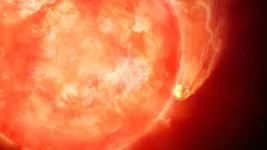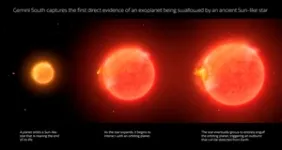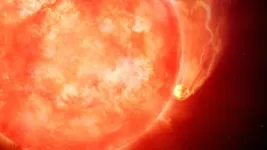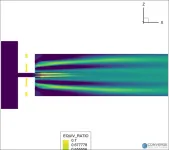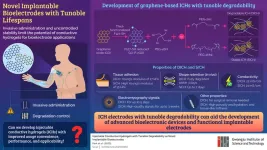(Press-News.org) By studying countless stars at various stages of their evolution, astronomers have been able to piece together an understanding of the life cycle of stars and how they interact with their surrounding planetary systems as they age. This research confirms that when a Sun-like star nears the end of its life, it expands anywhere from 100 to 1000 times its original size, eventually engulfing the system’s inner planets. Such events are estimated to occur only a few times each year across the entire Milky Way. Though past observations have confirmed the aftermath of planetary engulfments [1], astronomers have never caught one in the act, until now.
With the power of the Gemini South Adaptive Optics Imager (GSAOI) on Gemini South, one half of the International Gemini Observatory, operated by NSF’s NOIRLab, [2] astronomers have observed the first direct evidence of a dying star expanding to engulf one of its planets. Evidence for this event was found in a telltale “long and low-energy” outburst from a star in the Milky Way about 13,000 light-years from Earth. This event, the devouring of a planet by an engorged star, likely presages the ultimate fate of Mercury, Venus, and Earth when our Sun begins its death throes in about five billion years.
“These observations provide a new perspective on finding and studying the billions of stars in our Milky Way that have already consumed their planets,” says Ryan Lau, NOIRLab astronomer and co-author on this study, which is published in the journal Nature.
For most of its life, a Sun-like star fuses hydrogen into helium in its hot, dense core, which allows the star to push back against the crushing weight of its outer layers. When hydrogen in the core runs out, the star begins fusing helium into carbon, and hydrogen fusion migrates to the star’s outer layers, causing them to expand, and changing the Sun-like star into a red giant.
Such a transformation, however, is bad news for any inner-system planets. When the star's surface eventually expands to engulf one of its planets, their interaction would trigger a spectacular outburst of energy and material. This process would also put the brakes on the planet's orbital velocity, causing it to plunge into the star.
The first hints of this event were uncovered by optical images from the Zwicky Transient Facility. Archival infrared coverage from NASA’s Near-Earth Object Wide-field Infrared Survey Explorer (NEOWISE), which is able to peer into dusty environments in search of outbursts and other transient events, then confirmed the engulfment event, named ZTF SLRN-2020. “Our team’s custom reanalysis of all-sky infrared maps from NEOWISE exemplifies the vast discovery potential of archival survey data sets,” said NOIRLab astronomer Aaron Meisner, another co-author on the paper.
Distinguishing a planetary-engulfment outburst from other types of outbursts, such as solar-flare-type events and coronal-mass ejections, is difficult and requires high-resolution observations to pinpoint the location of an outburst and long-term measurements of its brightness without contamination from nearby stars.
Gemini South provided these essential data thanks to its adaptive-optics capabilities.
“Gemini South continues to expand our understanding of the Universe and these new observations support predictions for the future of our own planet,” said NSF Gemini Observatory program director Martin Still. “This discovery is a wonderful example of the feats we can accomplish when we combine world-class telescope operations and cutting-edge scientific collaboration.”
“With these revolutionary new optical and infrared surveys, we are now witnessing such events happen in real time in our own Milky Way — a testament to our almost certain future as a planet,” said Kishalay De, an astronomer at the Massachusetts Institute of Technology and lead author on the paper.
The outburst from the engulfment lasted approximately 100 days and the characteristics of its lightcurve, as well as the ejected material, gave astronomers insight into the mass of the star and that of its engulfed planet. The ejected material consisted of about 33 Earth masses of hydrogen and about 0.33 Earth masses of dust. “That's more star- and planet-forming material being recycled, or burped out, into the interstellar medium thanks to the star eating the planet,” said Lau. From this analysis, the team estimated that the progenitor star is about 0.8−1.5 times the mass of our Sun and the engulfed planet was 1−10 times the mass of Jupiter.
Now that the signatures of a planetary engulfment have been identified for the first time, astronomers have improved metrics they can use to search for similar events happening elsewhere in the cosmos. This will be especially important when Vera C. Rubin Observatory comes on line in 2025. For instance, the observed effects of chemical pollution on the remnant star when seen elsewhere can hint that an engulfment has taken place. The interpretation of this event also provides evidence for a missing link in our understanding of the evolution and final fates of planetary systems, including our own.
“I think there's something pretty remarkable about these results that speaks to the transience of our existence,” says Lau. “After the billions of years that span the lifetime of our Solar System, our own end stages will likely conclude in a final flash that lasts only a few months.”
More information
[1] While evidence of engulfment events has been found before — such as the resulting corpse of a star and the burnt out husk of a planet, suggesting the engulfment took place sometime in the distant past — the results presented here are the first direct evidence that it is happening as we are observing it.
[2] The Gemini South observations were made using Director’s Discretionary Time (Program ID: GS-2022A-DD-102, PI: K. De)
NSF’s NOIRLab (National Optical-Infrared Astronomy Research Laboratory), the US center for ground-based optical-infrared astronomy, operates the international Gemini Observatory (a facility of NSF, NRC–Canada, ANID–Chile, MCTIC–Brazil, MINCyT–Argentina, and KASI–Republic of Korea), Kitt Peak National Observatory (KPNO), Cerro Tololo Inter-American Observatory (CTIO), the Community Science and Data Center (CSDC), and Vera C. Rubin Observatory (operated in cooperation with the Department of Energy’s SLAC National Accelerator Laboratory). It is managed by the Association of Universities for Research in Astronomy (AURA) under a cooperative agreement with NSF and is headquartered in Tucson, Arizona. The astronomical community is honored to have the opportunity to conduct astronomical research on Iolkam Du’ag (Kitt Peak) in Arizona, on Maunakea in Hawai‘i, and on Cerro Tololo and Cerro Pachón in Chile. We recognize and acknowledge the very significant cultural role and reverence that these sites have to the Tohono O’odham Nation, to the Native Hawaiian community, and to the local communities in Chile, respectively.
Links
Research paper “An infrared transient from a star engulfing a planet”
Photos of the Gemini South telescope
Videos of the Gemini South telescope END
Astronomers witness star devouring planet: possible preview of the ultimate fate of Earth
Gemini South captures first direct evidence of an exoplanet being swallowed by an ancient Sun-like star
2023-05-03
ELSE PRESS RELEASES FROM THIS DATE:
Discovery suggests route to safer pain medications
2023-05-03
Strategies to treat pain without triggering dangerous side effects such as euphoria and addiction have proven elusive. For decades, scientists have attempted to develop drugs that selectively activate one type of opioid receptor to treat pain while not activating another type of opioid receptor linked to addiction. Unfortunately, those compounds can cause a different unwanted effect: hallucinations. But a new study led by Washington University School of Medicine in St. Louis has identified a potential route ...
XFELs show the final milliseconds of oxygen formation
2023-05-03
For the first time, scientists have been able to see the crucial final step in the reaction cycle of Photosystem II, during which oxygen is formed. Using serial femtosecond crystallography performed with the XFEL technique, they have managed to obtain more information on the interaction between Photosystem II and the Mn/Ca cluster. This has been shown in a new study by Uppsala University, published in the journal Nature.
The oxygen we breathe is produced by plants, algae and cyanobacteria, which use the energy of sunlight for powering the formation of oxygen. This is done by the Photosystem II enzyme, ...
To boost cancer immunotherapy’s fighting power, look to the gut
2023-05-03
Cancer immunotherapy has transformed the treatment of many types of cancer. Yet, for reasons that remain poorly understood, not all patients get the same benefit from these powerful therapies.
One potent factor in treatment outcome appears to be an individual’s gut microbiota — the trillions of microorganisms that live in the human intestine — according to new research led by investigators at Harvard Medical School and Dana-Farber Cancer Institute.
The study, done in mice and published May 3 in Nature, pinpoints how gut microbes enhance the body’s response to a common type of immunotherapy known as PD-1 checkpoint ...
Minoan eruption survey improves volcanic risk assessments
2023-05-03
Volcanic eruptions are spectacular, violent and dangerous. Large explosive eruptions can even have global impacts. To classify the size of volcanic eruptions, the magma volume and the deposition volume are determined. Volcanologists estimate these values in order to compare the size of different volcanic eruptions or to obtain a measure of the explosiveness of the eruption. However, it is often not possible to determine the values accurately. This makes it difficult to infer the actual volume of magma and to measure the complete extent of such eruptions. In particular, because the deposits of the most violent historical eruptions are partially or completely under water, which makes geological ...
Indo-Pacific corals more resilient to climate change than Atlantic corals
2023-05-03
UNIVERSITY PARK, Pa. — In the face of global warming and other environmental changes, corals in the Atlantic Ocean have declined precipitously in recent years, while corals in the Pacific and Indian Oceans are faring better. By describing several species of symbiotic algae that these corals need to grow, an international team led by Penn State has found that these mutualistic relationships from the Indo-Pacific may be more flexible and ultimately resilient to higher ocean temperatures than those in the Atlantic.
Coral reefs are vast geological structures made of calcium carbonate produced by coral animals whose colonies possess dense populations ...
More woodlands will not impact tourism
2023-05-03
Hiking, cycling, climbing and boating. When we take time off from work or school, we like to go out into nature. The landscape in other words play an important role for our vacations. To promote biodiversity and carbon sequestration there is a focus on planting more trees, especially in upland areas such as Howgill Fells. The Howgill Fells is located in the north-west of England and is known for its soft, rolling and open landscape. It is a popular area for tourists seeking the outdoors and hill-walking in particular. But how ...
Used coffee pods can be recycled to produce filaments for 3D printing
2023-05-03
An article published in the journal ACS Sustainable Chemistry & Engineering brings good news for coffee buffs: the plastic in used coffee pods can be recycled to make filament for 3D printers, minimizing its environmental impact.
The solution was successfully tested by research groups in Brazil at the Federal University of São Carlos (USFCar) and the State University of Campinas (UNICAMP), and in the United Kingdom at Manchester Metropolitan University (MMU).
“We produced new conductive and non-conductive filaments from waste polylactic acid [PLA] from used coffee machine ...
American Stroke Association names 2023 Stroke Heroes
2023-05-03
DALLAS, May 3, 2023 — Six local stroke heroes from across the country are being recognized by the American Stroke Association, a division of the American Heart Association, for their resiliency and dedication to rise up against stroke. Approximately 800,000 Americans have a stroke each year,[1] a leading cause of disability in the U.S., and one in four survivors will have another one.
The American Stroke Association’s annual Stroke Hero Awards honors stroke survivors, health care professionals and family caregivers. The ...
SwRI designs safer, more effective hydrogen injector for gas turbines
2023-05-03
SAN ANTONIO — May 3, 2023 —Southwest Research Institute is designing innovative hydrogen combustion systems for gas turbines used in power generation. The designs prevent flashback, a common concern in hydrogen-fueled combustion systems wherein the flame from the combustor travels into the nozzle, which can result in damaged equipment.
Hydrogen fuel has numerous benefits including the fact that it produces no carbon emissions during the combustion process. However, one of the things that is especially challenging is that it’s highly reactive, which makes it more difficult to work with than natural gas or the liquid fuels ...
Gwangju Institute of Science and Technology researchers enhance thermoelectricity with guided impurity position control
2023-05-03
Thermoelectric materials, substances that convert temperature difference into electricity, find a multitude of applications involving the conversion of waste heat into useful electrical energy. However, they often need to rely on heavy rare earth elements for efficient thermoelectric conversion. This, unfortunately, makes them expensive and environmentally hazardous. In recent years, conjugated polymer-based material has received attention as an environmentally benign alternative to the conventional rare earth metal-based thermoelectric materials.
Owing to their high ...
LAST 30 PRESS RELEASES:
Fecal tests reveal active termite attacks
Uterine fibroids linked to elevated heart disease risk
Dual use of cigarettes and vapes can reduce risks of smoking and help smokers quit
New bioelectronics device based on hydrogel- elastomer conductive nanomembranes
More yield through heterosis: IPK research team decodes gene interaction
James Webb telescope reveals spectacular atmospheric escape
ICE-CSIC leads a pioneering study on the feasibility of asteroid mining
Dramatic rise in young people using mental health services
Be careful trusting TikTok for gout advice
A study by the University of Seville links the vanishing of the specific heats at absolute zero with the principle of entropy increase
Anxiety and insomnia may lower natural killer cell count, potentially repressing immune function
How parasitic, asexual plants evolve and live
Research spotlight: A subset of patients with depression could benefit from anti-inflammatory treatment
New fully digital design paves the way for scalable probabilistic computing
Membrane electrode assembly design for high-efficiency anion exchange membrane water electrolysis
U.S. debt ceiling disputes show measurable impact on global crude oil markets
Climate extremes triggered rare coral disease and mass mortality on the Great Barrier Reef
Direct observation reveals “two-in-one” roles of plasma turbulence
Humans rank between meerkats and beavers in monogamy ‘league table’
US fossil reveals early mass-burial event and ancient microbial attack
Sedative choice could improve outcomes for breathing tube patients
New superconducting thin film for quantum computer chips
Simulations reveal protein "dynamin" constricts cell membranes by loosening its grip
Nearly 1 in 5 UK emergency department patients cared for in corridors/waiting rooms
Heavy energy drink intake may pose serious stroke risk, doctors warn
Violence against women and children among top health threats: New global study reveals disease burden far larger than previously estimated
Predicting who is at risk of developing type 1 diabetes, as new drugs now available
New gene-mapping method unlocks hidden drivers of cancer
Ocean current and seabed shape influence warm water circulation under ice shelves
Call to increase funding for ‘invisible’ Deaf victim-survivors of domestic abuse
[Press-News.org] Astronomers witness star devouring planet: possible preview of the ultimate fate of EarthGemini South captures first direct evidence of an exoplanet being swallowed by an ancient Sun-like star
